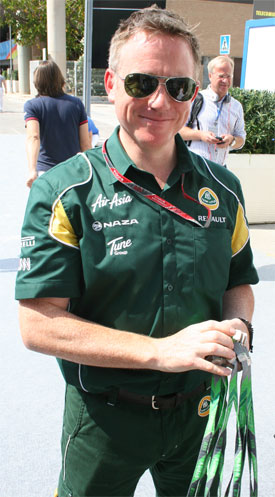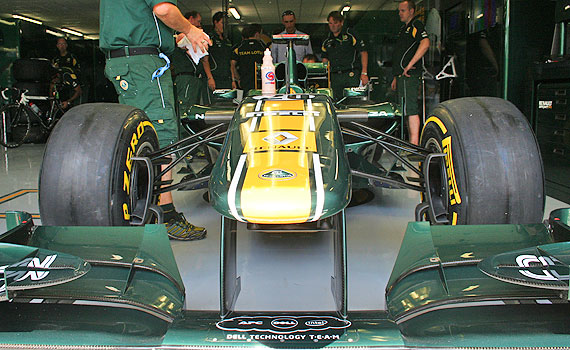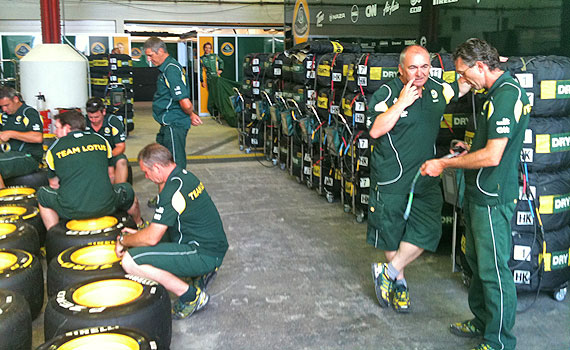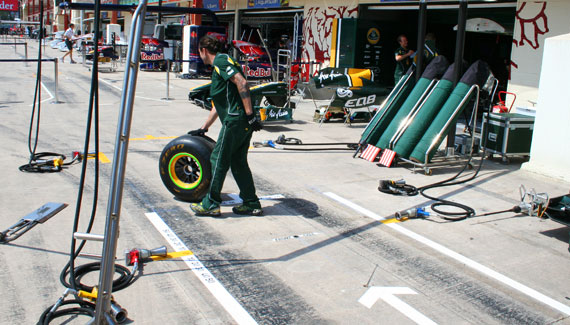This year, Formula 1 returned to Valencia, Spain for the European Grand Prix. The temporary Valencia Street Circuit around the America’s Cup Marina on the Mediterranean Sea provides the perfect backdrop for the very best drivers in the world to show off the most technologically advanced cars in the world.
 Before the events of the 2011 European Grand Prix officially kicked off, I had the amazing opportunity to visit the Team Lotus paddock where I got an inside look at the power of the engines, the design of the body work, the unique technology and the human effort that goes into competing for the World Driving and Constructors’ Championships.
Before the events of the 2011 European Grand Prix officially kicked off, I had the amazing opportunity to visit the Team Lotus paddock where I got an inside look at the power of the engines, the design of the body work, the unique technology and the human effort that goes into competing for the World Driving and Constructors’ Championships.
Upon arriving at the track (along with a few others from #BlogTripF1), I received my shiny, green, titanium VIP credentials and proceeded to the paddock entrance where I met up with Tom Webb of Team Lotus.
After a quick introduction, we walked down the row of paddocks which were located in the boat sheds built for the 32nd America’s Cup. Tom explained how the paddock order is determined by the final results of the 12 competing teams in the previous year’s Constructors’ Championship. While Team Lotus was located near the end, this was only their second year together. Of the three teams that joined the ranks of Formula 1 in 2010, Team Lotus has been the most successful. This year, with an experienced technical team and a decent annual budget in the neighborhood of $60 million, the team hopes to score their first championship points ever.
Upon entering the garage area, I saw purpose built trailers on either side. Hydraulic lifts are used to elevate the floors of these trailers which nearly double their size. Offices inside the trailers housed many of the team’s technicians and engineers who were carefully planning the qualifying and race strategies for the weekend.
Just outside the offices, a few team members were preparing the team’s tire allocation for the weekend. This year, Pirelli is Formula 1’s sole tire supplier. Every race weekend, the Italian tire company supplies each driver with 11 sets of tires that are made up of two different compounds. Depending on the track and conditions, the compounds vary between hard, medium, soft and super soft. For this race, as high temperatures were expected, the teams were given the medium and soft compound tires.
Next, Tom led us to the area where two members of the team were working on carbon fiber wings and parts of the bodywork. He explained how the carbon fiber comes in paper thin strips and is layered to create the various pieces. When handed a piece of the rear wing and the engine cover, the light weight of each piece took me by surprise.
After a quick walk through the engine and gearbox area as well as the primary telemetry station (where photos were strictly prohibited), we came to the cars themselves.
Piloted by Finland’s Heikki Kovalainen and Italian veteran Jarno Trulli, the cars and their drivers have stepped up the competition a bit this year. Tom mentioned that Kovalainen, in particular, has demonstrated that he is comfortable running in the middle of the field. He added that the team expects him to be fighting it out with the midfield cars before the season is over.
The next two stops on the tour included the two biggest highlights of the visit for me which were standing in the actual pit boxes and getting an overview of the steering wheel from Jarno Trulli’s car.
As I stood in the pit box of Heikki Kovalainen, I was amazed at how compact it was. The idea that sixteen members of the pit crew cram together in the tiny spot to change four tires is quite remarkable. Tom explained how working in extremely tight quarters creates other hazards as well. For example, used tires and other parts of the car are extremely hot, making it very important for all members of the pit crew to be extremely cognisant of where they are and where they are putting used tires and parts.
The efficiency of the pit crew was evident during the race on Sunday. I was sitting across from the Team Lotus pit and saw the team complete a pit stop in about two and a half seconds. The car came off the track and into the pit. I counted …one one thousand, two one thousand, three one thousand… and the car was already gone.
Next, Tom showed us the intricacies of a Formula 1 car’s steering wheel. A steering wheel from a Formula 1 car is like a piece of artwork in and of itself. In addition to the multiple paddles used to change gears on the underside, the Team Lotus steering wheel has thirteen buttons, nine dials and one switch.
Here’s a quick video of Tom explaining what some of the various buttons and dials are used for.
After walking back through the entire paddock, the tour concluded with a quick trip to the Team Lotus hospitality area which housed the team’s shower facilities, catering area and a special section in front where drivers and other members of the team would meet the press.
Tom then said the words I least wanted to hear at that moment, “Well, that’s about it.” With that, he showed us back to the paddock entrance, collected our shiny, green, titanium credentials and then we said our goodbyes. My trip through the Team Lotus paddock in Valencia is certainly something I will never forget. I want to offer a huge thank you to my good friend Keith Jenkins of Velvet Escape as well as Tom Webb of Team Lotus for making it all possible.







